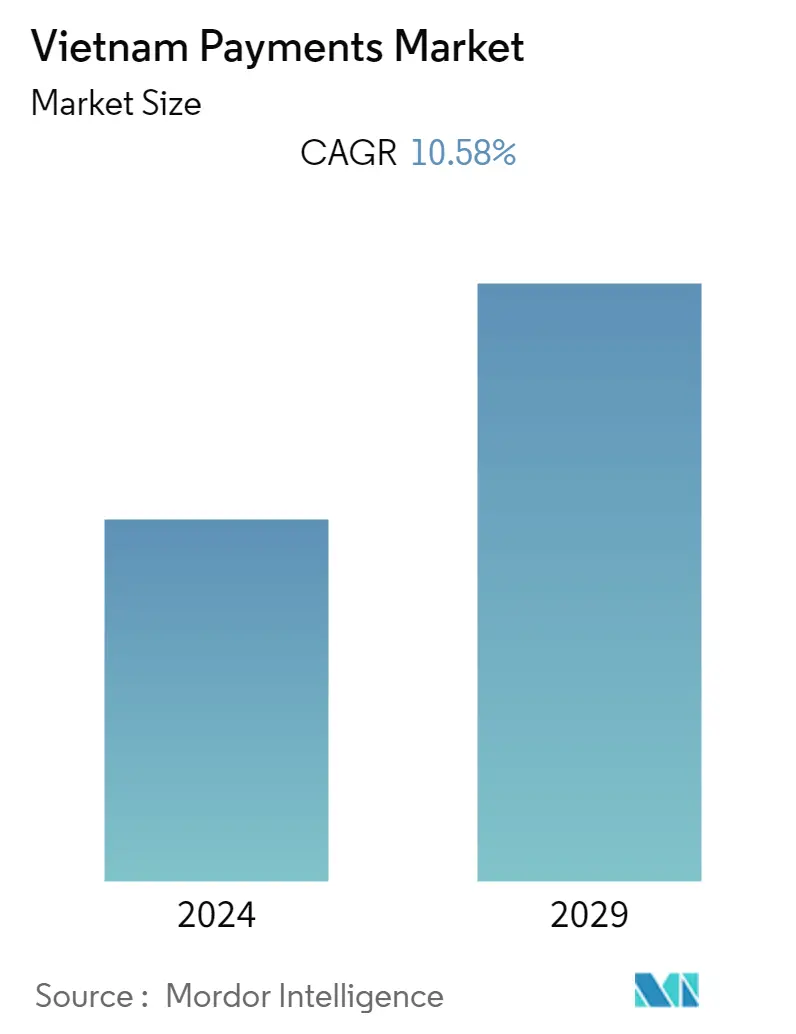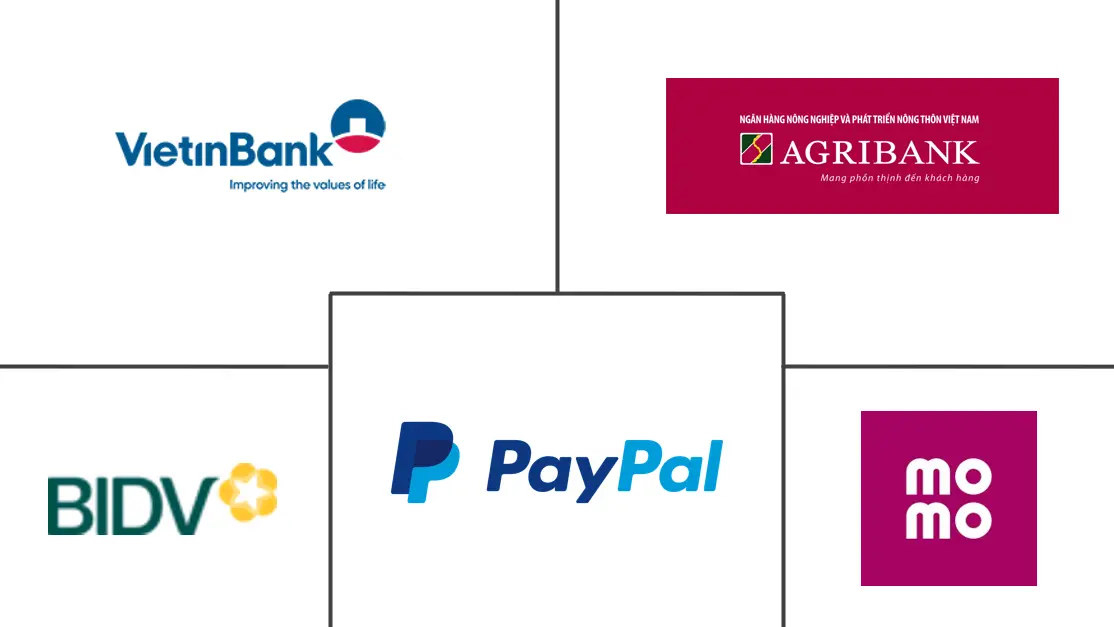Market Size of Vietnam Payments Industry

| Study Period | 2019 - 2029 |
| Base Year For Estimation | 2023 |
| Forecast Data Period | 2024 - 2029 |
| Historical Data Period | 2019 - 2022 |
| CAGR | 10.58 % |
| Market Concentration | Low |
Major Players
*Disclaimer: Major Players sorted in no particular order |
Vietnam Payments Market Analysis
The Vietnam payments market is anticipated to register a CAGR of over 10.58% over the forecast period (2022-2027). Enablement programs by key retailers and the government encouraging digitization of the market are some of the drivers of the payments market in Vietnam.
- Cashless payment techniques such as contactless cards, QR codes, and mobile banking for digital and e-commerce services are growing increasingly popular in Vietnam, according to Le Van Tuyen, Deputy Director of the State Bank of Vietnam's Payment Department. Further added that the country has seen a significant movement away from cash in favor of electronic payment methods, which is also a goal of a cashless payment development strategy for the period 2021-2025.
- To ensure seamless cashless payment transactions, the National Payment Corporation of Vietnam (NAPAS), an intermediate payment service provider registered by SBV, has reserves equivalent to 50% of its capacity. The amount of transactions accounts for barely over 40% of the system's intended capacity, even during peak hours. In order to fulfill market demands, it has also produced new goods and services on a regular basis.
- NAPAS has introduced a set of domestic chip cards, comprising debit, prepaid, and credit cards, to complement the central bank's objective to move away from magnetic stripe cards and toward chip cards.
- High proliferation of e-commerce, including the rise of m-commerce and cross-border e-commerce supported by the increase in purchasing power, and growth of real-time payments, especially Buy Now Pay Later in the country, are the drivers of the payment market. While lack of a standard legislative policy remains, especially in the case of cross-border transactions tends to restrain the market growth.
- The emergence of COVID-19 in Vietnam has prompted residents to switch to non-cash payment methods, allowing the virus to spread more freely. The government quickly established large-scale social separation or confinement regulations after COVID-19 breakouts. Inevitably, the cashless society will cover and prioritize the majority of transactions, indicating that consumers would unconsciously embrace mobile wallets as an official payment method for even basic goods.
Vietnam Payments Industry Segmentation
The Vietnam Payments Market is Segmented by Mode of Payment (Point of Sale (Card Payments, Digital Wallet, Cash), Online Sale (Card Payments, Digital Wallet)), and by End-user Industries (Retail, Entertainment, Healthcare, Hospitality). or POS, all transactions made on physical sales are within the market range of credit or debit card payments. This includes all face-to-face transactions, not just traditional in-store transactions, regardless of location. In both cases, cash payments are also an option for e-commerce sales.
| By Mode of Payment | ||||||
| ||||||
|
| By End-user Industry | |
| Retail | |
| Entertainment | |
| Healthcare | |
| Hospitality | |
| Other End-user Industries |
Vietnam Payments Market Size Summary
The Vietnam payments market is experiencing significant growth, driven by a shift towards cashless payment methods such as contactless cards, QR codes, and mobile banking. This transition is supported by government initiatives and retailer programs aimed at digitizing the economy. The National Payment Corporation of Vietnam (NAPAS) plays a crucial role in facilitating this shift by ensuring robust payment infrastructure and introducing new products like domestic chip cards. The rise of e-commerce, particularly m-commerce and cross-border transactions, along with the increasing adoption of real-time payment solutions, are key factors propelling the market forward. However, the lack of standardized legislative policies, especially for cross-border transactions, poses challenges to market expansion.
The COVID-19 pandemic has accelerated the adoption of non-cash payment methods, as social distancing measures encouraged consumers to embrace mobile wallets and other digital payment solutions. The Vietnamese government has set ambitious goals for the digital economy, aiming to increase its contribution to GDP significantly by 2025. Collaborations between financial institutions and payment providers, such as Visa's partnerships with local banks, are enhancing the availability and convenience of cashless payment options. The market remains fragmented, with major players like PayPal, MoMo, and Samsung Pay investing in innovative payment technologies. Recent developments, including strategic partnerships and system modernizations, are expected to further enhance the payment landscape in Vietnam.
Vietnam Payments Market Size - Table of Contents
-
1. MARKET INSIGHTS
-
1.1 Market Overview
-
1.2 Industry Stakeholder Analysis
-
1.3 Industry Attractiveness-Porter's Five Force Analysis
-
1.3.1 Bargaining Power of Suppliers
-
1.3.2 Bargaining Power of Buyers/Consumers
-
1.3.3 Threat of New Entrants
-
1.3.4 Threat of Substitute Products
-
1.3.5 Intensity of Competitive Rivalry
-
-
1.4 Evolution of the payments landscape in the country
-
1.5 Key market trends pertaining to the growth of cashless transaction in the country
-
1.6 Impact of COVID-19 on the payments market in the country
-
-
2. Market Segmentation
-
2.1 By Mode of Payment
-
2.1.1 Point of Sale
-
2.1.1.1 Card Payments (includes Debit Cards, Credit Cards, Bank Financing Prepaid Cards)
-
2.1.1.2 Digital Wallet (includes Mobile Wallets)
-
2.1.1.3 Cash
-
2.1.1.4 Others
-
-
2.1.2 Online Sale
-
2.1.2.1 Card Payments (includes Debit Cards, Credit Cards, Bank Financing Prepaid Cards)
-
2.1.2.2 Digital Wallet (includes Mobile Wallets)
-
2.1.2.3 Others (includes Cash on Delivery, Bank Transfer, and Buy Now, Pay Later)
-
-
-
2.2 By End-user Industry
-
2.2.1 Retail
-
2.2.2 Entertainment
-
2.2.3 Healthcare
-
2.2.4 Hospitality
-
2.2.5 Other End-user Industries
-
-
Vietnam Payments Market Size FAQs
What is the current Vietnam Payments Market size?
The Vietnam Payments Market is projected to register a CAGR of 10.58% during the forecast period (2024-2029)
Who are the key players in Vietnam Payments Market?
VietinBank Group, Vietnam Bank for Agriculture and Rural Development, Bank for Investment and Development of Vietnam, PayPal Pte. Ltd. and MoMo are the major companies operating in the Vietnam Payments Market.

